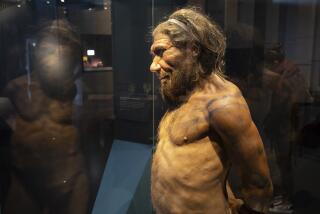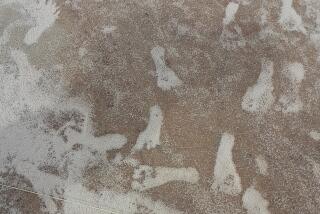Opinion: Science accepted as fact is often ridiculed at first. Blame turf-protecting scientists
To the editor: It is common for new discoveries in science â like the fossils found in San Diego that suggest humans may have inhabited North America more than 100,000 years ago â to cause real anger and upset. (âArchaeology as blood sport: How an ancient mastodon ignited debate over humansâ arrival in North America,â Opinion, Dec. 22)
When some scientistsâ life work is destroyed by new information, there is often a fight to keep the paper from being published. I have a personal experience with the scientific discovery of new information.
I worked as a computer programmer for the Carnegie Institute of Washington in Pasadena. My boss was Robert Howard, a solar physicist. Around 1980, he and researcher Barry LaBonte, analyzing Doppler data on the sun, found that alternating fast and slow streams of solar rotating material existed on the sun. These streams started at the poles and symmetrically moved to the equator over a solar cycle (12 years).
This was a fundamental discovery that upset some scientistsâ life work. It was difficult to get the paper reviewed because of reviewersâ resistance. This discovery is now accepted as fact because it has been verified by other groups using other data.
The fight and the verification is a necessary part of the scientific method.
John Boyden, Sierra Madre
..
To the editor: Another California-based puzzlement provides possible evidence of much earlier human settlement in the Americas.
Scientists usually trace first migrations from Asia to Alaska across an ancient Bering Strait land bridge to about 15,000 years ago. But this tenet gets roiled whenever earlier artifacts appear.
In the 1960s, renowned paleoanthropologist Louis Leakey, who famously found stone tools and fossilized bones that proved humankindâs African origin, spent time on digs in the Mojave Desert after viewing rocks that looked hand-chipped. When he declared that humans may have made made crude knives, axes and pounders at this Calico quarry some 100,000 years ago, his work was ridiculed. But where else do geological deposits have large collections of similar rocks chipped solely by natural forces?
So were humans here at a very early time, making stone tools to hunt and butcher animals? Some day, fossilized human remains could turn up.
Barbara Marinacci, Pacific Palisades
..
To the editor: I am not an archaeologist, but I do understand what a scientist is.
A true scientist would never refuse point blank to look at the raw data (here, bones and stones and their relative positions), instead choosing to deliver ad hominem insults about the discovery, researchers, interpretations or publications about these things.
Mona Baumgartel, Encinitas
Follow the Opinion section on Twitter @latimesopinion and Facebook
More to Read
A cure for the common opinion
Get thought-provoking perspectives with our weekly newsletter.
You may occasionally receive promotional content from the Los Angeles Times.










